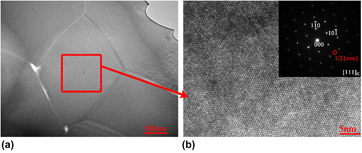Crossref Citations
This article has been cited by the following publications. This list is generated based on data provided by
Crossref.
Verma, Rolly
and
Rout, S. K.
2019.
Frequency-dependent ferro-antiferro phase transition and internal bias field influenced piezoelectric response of donor and acceptor doped bismuth sodium titanate ceramics.
Journal of Applied Physics,
Vol. 126,
Issue. 9,
Yadav, Arun Kumar
Fan, Huiqing
Yan, Benben
Wang, Chao
Ma, Jiangwei
Zhang, Mingchang
Wang, Weijia
Dong, Wenqiang
and
Wang, Shuren
2020.
Enhanced storage energy density and fatigue free properties for 0.94Bi0.50(Na0.78K0.22)0.50Ti1-(Al0.50Nb0.50) O3-0.06BaZrO3 ceramics.
Ceramics International,
Vol. 46,
Issue. 10,
p.
17044.
Yadav, Arun Kumar
Fan, Huiqing
Yan, Benben
Wang, Chao
Zhang, Mingchang
Ma, Jiangwei
Wang, Weijia
Dong, Wenqiang
and
Wang, Shuren
2020.
High energy storage density and stable fatigue resistance of Na0.46Bi0.46Ba0.05La0.02Zr0.03Ti0.97-Sn O3 ceramics.
Ceramics International,
Vol. 46,
Issue. 5,
p.
5681.
Li, Ling
Fang, Di
Wang, Rui-Xue
Hao, Jigong
Gu, Zheng-Bin
and
Zhang, Shan-Tao
2020.
Domain evolution and improved electrical property of BiMn2/3Nb1/3O3 doped 0.8Na0.5Bi0.5TiO3-0.2K0.5Bi0.5TiO3.
Ceramics International,
Vol. 46,
Issue. 6,
p.
7947.
Liang, Guochuang
Zhang, Yueming
Zhu, Jinian
Zhang, Qi
and
Peng, Biaolin
2021.
Tailoring and improving the strong-electric-field electrical properties of the BNT-BT ferroelectric ceramics by a functional-group-doping.
Ceramics International,
Vol. 47,
Issue. 5,
p.
6584.
Zhou, Xuefan
Xue, Guoliang
Luo, Hang
Bowen, Chris R.
and
Zhang, Dou
2021.
Phase structure and properties of sodium bismuth titanate lead-free piezoelectric ceramics.
Progress in Materials Science,
Vol. 122,
Issue. ,
p.
100836.
Habib, Muhammad
Munir, Muhammad
Akram, Fazli
Lee, Soonil
Song, Tae-Kwon
Turak, Ayse
Kim, Myong-Ho
and
Hussain, Ali
2021.
Structural evolution and electromechanical properties of SrTiO3-modified Bi0.5Na0.5TiO3–BaTiO3 ceramics prepared by sol-gel and hydrothermal methods.
Materials Chemistry and Physics,
Vol. 266,
Issue. ,
p.
124529.
Chen, Juan-Nan
Kang, Connie
Hou, Rui-Min
Zhao, Xian
and
Wang, Chun-Ming
2021.
Dielectric, ferroelectric, and piezoelectric properties of Gd-modified CaBi2Nb2O9 high Curie temperature ceramics.
Journal of Materials Research,
Vol. 36,
Issue. 5,
p.
1086.
Zhao, Nianshun
Fan, Huiqing
Li, Cheng
Huang, Feng
Cao, Jianhua
and
Li, Zheng
2021.
Large strain and low hysteresis in (0.64-x) Bi0.5Na0.5TiO3- 0.36Sr0.7Bi0.2TiO3- x(K0.5La0.5)(Ti0.9Zr0.1)O3 piezoceramics.
Ceramics International,
Vol. 47,
Issue. 21,
p.
30399.
Shiqi, Zheng
Qiang, Li
Qian, Li
Bingxu, Ji
Fan, Yang
Huiqing, Fan
and
Weijia, Wang
2023.
Large electrostrain at high temperature in bismuth sodium titanate-based piezoelectric ceramics.
Ceramics International,
Vol. 49,
Issue. 20,
p.
32642.
Li, Hui-Lin
Chen, Yi-Nuo
Wang, Qian
and
Wang, Chun-Ming
2024.
Superior piezoelectric performance in holmium-substituted high-TC Bi5Ti3FeO15.
Materials Today Communications,
Vol. 41,
Issue. ,
p.
111118.
Chen, Fukang
Yang, Lishun
Feng, Haoran
Li, Qin
Zeng, Xinyu
Yu, Kun
Song, Chunlin
Yan, Yan
Jin, Li
and
Zhang, Dou
2024.
An ultrahigh energy storage efficiency and recoverable density in Bi0.5Na0.5TiO3 with the modification of Sr0.85La0.1TiO3 via viscous polymer process.
Journal of Materiomics,
Vol. 10,
Issue. 3,
p.
566.
Li, Hui-Lin
Chen, Yi-Nuo
Wang, Qian
Liang, En-Meng
Wan, Yi-Jun
Yu, Xin-Yu
Li, Zhi-Qiang
Zhao, Xian
and
Wang, Chun-Ming
2025.
Enhanced piezoelectric properties in high-TC Bi5Ti3FeO15 via dysprosium substitution: a rare-earth doping approach for superior performance.
Journal of the Australian Ceramic Society,
Vol. 61,
Issue. 4,
p.
1571.
He, Yang
Chen, Fukang
Qi, Meng
Zhao, Xing
Ji, Jiayi
Kang, Xiaonan
Yan, Yan
Liu, Jingsong
Ai, Taotao
Cao, Liang
Hou, Junfeng
Vtyurin, Alexander N.
Manan, Abdul
He, Zhanbing
Song, Chunlin
and
Liu, Gang
2025.
Achieving improved dielectric energy storage properties in Na0.4505Bi0.3825Sr0.136Nb0.085Er0.015TiO3 ferroelectric ceramics via La modification and processing optimization.
Ceramics International,
Vol. 51,
Issue. 19,
p.
28289.


